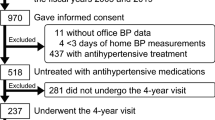Abstract
For reliable control of hypertension, it is essential to know the prevalence of the white coat effect (WCE), which is defined as either a difference of 10 mmHg or more in systolic blood pressure (BP) and/or a difference of 5 mmHg or more in diastolic BP measured by a general practitioner (GP), a nurse, or the patient him/herself. The objective was to assess the WCE in hypertensive patients visiting GPs in primary healthcare centres. A blinded, randomised study in six primary healthcare centres was conducted, where eight GPs, nine nurses and 210 patients (92 men and 118 women) on a hypertension control regimen participated. Heart rate and BP in GPs', nurses' and self-service rooms were measured twice using a sphygmomanometer and an automatic device. Altogether, 148 patients (70%) performed the self-measurements of BP and heart rate perfectly successfully in all the three rooms. These were included in the final analyses. One out of three patients (33%) showed a marked alerting WCE in the GP's room (systolic BP rose by at least 10 mmHg and/or diastolic BP by at least 5 mmHg). On the contrary, one out of 10 (10%) showed a marked relaxing WCE in the GP's room (systolic BP decreased by at least 10 mmHg and/or diastolic BP by at least 5 mmHg). It can be concluded that the WCE in general practice has two faces: an alerting reaction and a relaxing reaction. This should be taken into account in hypertension control.
This is a preview of subscription content, access via your institution
Access options
Subscribe to this journal
Receive 12 digital issues and online access to articles
$119.00 per year
only $9.92 per issue
Buy this article
- Purchase on Springer Link
- Instant access to full article PDF
Prices may be subject to local taxes which are calculated during checkout

Similar content being viewed by others
References
Mancia G et al. Effects of blood-pressure measurement by the doctor on patients' blood pressure and heart rate Lancet 1983 2: 695–698
Mancia G et al. Alerting reaction and rise in blood pressure during measurement by physician and nurse Hypertension 1987 9: 209–215
Mancia G, Zanchetti A . Editors' corner: White-coat hypertension: misnomers, misconceptions and misunderstandings. What should we do next? J Hypertens 1996 14: 1049–1052
La Batide-Alanore A et al. Comparison of nurse- and physician-determined clinic blood pressure levels in patients referred to hypertension clinic: implications for subsequent management J Hypertens 1999 18: 391–398
Enström I, Pennert K, Lindholm LH . Difference in blood pressure, but not in heart rate, between measurements performed at a health centre and at a hospital by one and the same physician J Hum Hypertens 2000 14: 355–358
WHO/ISH Guidelines Sub-Committee. 1993 Guideline Sub-Committee. 1993 Guideline for the management of mild hypertension: memorandum from World Health Organization/International Society of Hypertension Meeting Highlights of 1993 Guidelines J Hypertens 1993 11: 905–918
O'Brien E, Mee F, Atkins N, Thomas M . Evaluation of three devices for self-measurement of blood pressure according to the revised British Hypertension Society Protocol: the Omron HEM-705CP, Philips HP5332 and Nissei DS-175 Blood Press Monit 1996 1: 55–61
Millar J, Accioly J . Measurement of blood pressure may be affected by an interaction between subject and observer based on gender J Hum Hypertens 1996 10: 449–453
Author information
Authors and Affiliations
Corresponding author
Rights and permissions
About this article
Cite this article
Kumpusalo, E., Teho, A., Laitila, R. et al. Janus faces of the white coat effect: blood pressure not only rises, it may also fall. J Hum Hypertens 16, 725–728 (2002). https://doi.org/10.1038/sj.jhh.1001475
Received:
Revised:
Accepted:
Published:
Issue Date:
DOI: https://doi.org/10.1038/sj.jhh.1001475



